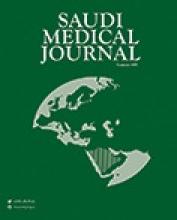Abstract
OBJECTIVE: To determine the prevalence of and the risk factors for Peripheral arterial disease (PAD) in a primary health care setting in Saudi Arabia.
METHODS: We conducted a prospective cross-sectional study of Saudi patients aged >/= 45 years, who attended the primary health care center at King Khalid University Hospital between February 2006 and March 2006. A pre-designed questionnaire was used for each patient. Peripheral arterial disease was diagnosed, if the Ankle-Brachial index by Doppler were <0.90 and if the patient had signs or symptoms suggestively for PAD. Prevalence was estimated with 95% confidence intervals (CI), and multivariable logistics regression analyses were preformed to identify factors associated with PAD.
RESULTS: A total of 471 patients were recruited. The mean age was 56 years and 32.3% were women. The prevalence of PAD was 11.7% (95% CI: 8.9-14.9%), and 92.7% of them were asymptomatic. Patients with PAD were slightly older than patients without PAD, suffered more often from diabetes, hypertension, lipid disorders, smoking, cerebrovascular event, and coronary artery disease.
CONCLUSION: Prevalence of and risk factors for PAD in Saudi Arabia seem to be higher. A nationwide screening program is needed to confirm these results.
- Copyright: © Saudi Medical Journal
This is an open-access article distributed under the terms of the Creative Commons Attribution-Noncommercial-Share Alike 3.0 Unported, which permits unrestricted use, distribution, and reproduction in any medium, provided the original work is properly cited.






